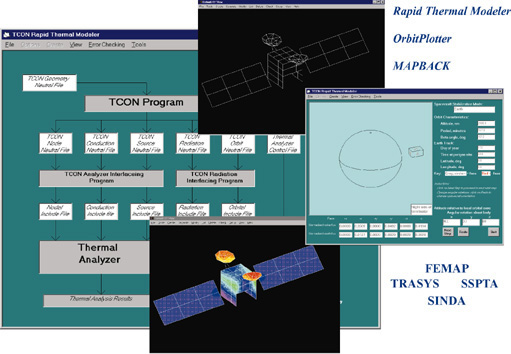Taking the Heat Off Thermal Loads
A turn-of-the-century telescope is under development at Goddard Space Flight Center. The Next Generation Space Telescope (NGST) is a follow-on to the already orbiting Hubble Space Telescope. NGST will be imbued with the ability to visit a time when galaxies were young. This pioneering, highly advanced scientific observatory will observe the "dark zone," a period when primordial seeds began to evolve into the galaxies and stars we see today.
A major engineering challenge awaits NGST builders. A tool that is being employed to help engineers grapple with the complexity of the NGST is offered by Frederick A. Costello, Incorporated (FAC, Inc.), a concurrent engineering software developer based in Herndon, Virginia. Costello's TCONTM software enables graphical user-interface programs to create three-dimensional thermal models. The NGST is to be passively cooled. Solar heating must be reduced by a factor of 10,000 in NGST. The observatory's proposed capabilities will far exceed anything possible from the ground or in space.
Costello's software is an affordable approach to create full three-dimensional thermal models efficiently and accurately. The product reduces modeling time to one-third the amount of time required by conventional, less-automated methods. TCON software can convert over 4500 nodes and 4500 radiation surfaces. Color temperature contours make presentation of the software's assessment of thermal characteristics quick, easy, and effective.
Goddard Space Flight Center awarded Costello a Small Business Innovation Research (SBIR) contract to develop a low-cost computer program for integrating thermal modeling with other engineering disciplines. That SBIR funding sparked the innovative software, developing a whole new line of business for the consulting company. The software has been sold to NASA and to major American and foreign companies. It has also been adopted by developers of commercial geosynchronous Earth orbiting (GEO) and low Earth orbiting (LEO) satellites.
Since 1978, FAC, Inc. has offered engineering design analysis and testing services. The company has served a range of clients in the government--about 20 percent of the business--with the remaining 80 percent representing the private sector.
FAC, Inc. engineering modules can also be used to define and view the orbit of a spacecraft interactively on the screen. Attitude control modes, attitudes, and altitudes can be adjusted while viewing the orbit, as environmental flux data are updated on the screen for relative positioning of the Sun and the Earth with respect to each axis of the spacecraft. Defining spacecraft attitudes for a spinning or trajectory-bound spacecraft is automatic, no matter what the spin axis. Another software module provides the engineer with an automated method of transferring the temperature data from the thermal analyzer to the structural analyzer, even when the two models are dissimilar.
Future versions of the software are being readied. These modifications permit software interfaces with other graphical user-interface programs and thermal analyzers.
In the field of aerospace thermal design, FAC, Inc. has worked from cryogenics to ablation. Industries served by the company include electronics firms, aerospace companies, makers of industrial processes and equipment, energy technology groups, and the defense market.
FAC, Inc. has designed many temperature-control systems for spacecraft and instruments, such as the Hubble Space Telescope, the TOMS Earth-monitoring probe, and the Compton Gamma Ray Observatory.
TMTCON, Rapid Thermal Modeler, OrbitPlotter, and MAPBACK are trademarks of Frederick A. Costello, Incorporated.

TMTCON Concurrent Engineering Software, is a thermal translation program that enables graphical user-interface programs to create full thermal models efficiently and accurately. The different modules of TCON are the Rapid Thermal Modeler, OrbitPlotter, MAPBACK, and SINDAFAC.













